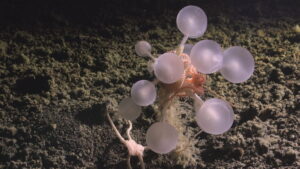I’ve long been a big fan of Greek mythology and all the wondrous beasts that tested, and sometimes bested, mythical heroes. One such creature was the chimera, a grotesque hybrid of a lion, goat, and snake. But chimeras are not only fairy tales or figments of an overactive ancient Greek imagination.
A chimera is an organism with two different genetic materials or DNA, often resulting in unusual physical characteristics and genetic mutations. Scientists can create chimeras, or they can occur naturally.
Chimerism in humans
Though rare, chimerism in humans can emerge as early as conception. While pregnant, a mother and baby exchange DNA, making them “microchimeras.”

Chimera in humans can manifest in heterochromia. Photo: Shutterstock
Chimerism also occurs when two embryos fuse. This is called twin chimerism or the “vanishing twin phenomenon.” The resulting individual takes on cells from both embryos, resulting in a mixed genetic makeup. The baby that’s born usually displays one or more of the following: different-colored eyes, mixed skin tones or birthmarks, patches of hair with different textures, or both male and female genitalia.
Sometimes, twin chimerism can make DNA testing difficult, particularly paternity and maternity tests. If a father or mother is a chimera, there is a chance that the DNA of his or her vanished twin could pass to a child.
Chimerism can also save lives. If someone has a blood transfusion or an organ transplant, they take on some of the DNA of the donor. The same goes for bone marrow transplants. If the transplant is successful, the donor’s stem cells migrate to the recipient’s bone marrow, where they produce blood cells. As a result, their cells and blood type will change.
Chimerism is not always obvious, and many people pass through life not knowing that they are an anomaly.
Human-ape hybrids?
In the 1920s, Soviet biologist Ilya Ivanov created a stronger and more resilient horse using artificial insemination. He aimed to increase agricultural production. He also created animal hybrids, like the zeedonk (zebra-donkey) and zubron (bison-cow).
After these successes, Ivanov turned his attention to creating a race of human-ape hybrids. Ivanov appealed to the Soviet government and received a grant of $10,000 to prove Darwin’s theory of evolution. He took his venture to French Guinea, where he inseminated local women with chimpanzee sperm without their knowledge. He led the women to believe it was a medical exam.
His horrific experiments did not work, and he was disgraced. Eventually, the Soviets exiled him to Kazakhstan, where he died in the early 1930s.

Chimeric mice. Photo: National Institute of Health
Allegedly, another set of chimera experiments occurred in China in the 1960s. Unconfirmed reports from the Wenhui Bao newspaper stated that Chinese scientists succeeded in impregnating a female chimp with human sperm. According to a scientist quoted in the paper, the authorities arrested the scientists during the Cultural Revolution, and the chimp died of neglect.
Other human-animal hybrids
In the 1980s, Stanford University scientists injected mice with human stem cells to try to develop a human immune system in them.
In 2020, scientists at the State University of New York at Buffalo and Roswell Park Comprehensive Cancer Center successfully implanted human stem cells into a mouse embryo. The mouse had 4% human cells, the highest percentage ever achieved. Over two weeks, the embryo developed human eye cells and red blood cells. Scientists hope to treat diseases with the cells.
In 2003, scientists in China created a hybrid embryo using human and rabbit cells. The purpose of the experiment was for the rabbit to grow human organs, cells, or tissue to harvest for transplants. They also inserted human cells into pig embryos, hoping that the pigs’ kidneys would have human cells.
Most recently, experiments by Juan Carlos Izpisua Belmonte and his team at the Salk Institute created a human-monkey chimera embryo. It took four years, and the embryo successfully grew for a few days before the team destroyed it. His team also produced a rat-mouse hybrid by injecting stem cells from rats into mouse embryos.
Ethical concerns
Researchers believe that hybrids can provide us with organs for transplants. Others think they could hold the key to curing diseases like AIDS, Parkinson’s Disease, Hepatitis, or neurodegenerative diseases.
By introducing human stem cells into developing ape embryos, scientists hope to investigate the similarities and differences between species. This could help unlock breakthroughs in regenerative medicine, organ transplantation, and the evolution of certain traits.
Rats and mice are often used in genetic research because they have surprising similarities to humans in immune system structure, genetic makeup, and physiology.
Transplant waiting lists can be extremely long. It can take many years before a prospective patient reaches the top of the list. So, for many, the natural reaction to chimera experimentation is favorable.
However, bioengineering also raises ethical concerns. If scientists created a successful human-animal hybrid, would it be entitled to human rights? Does “playing God” with chimera experiments carry unforeseen consequences? The topic is controversial, and most governments place restrictions on chimera experimentation.
Conclusion
Most governments don’t allow scientists to inject animal cells into a human or human embryo to respect the dignity of human life. However, scientists are permitted to inject human cells into animal embryos. These embryos are not carried to term and are usually destroyed after the experiment is finished. Because these experiments are controversial, researchers usually do not have access to public funding.






